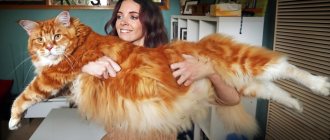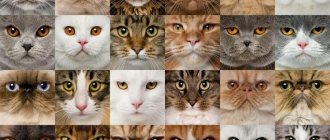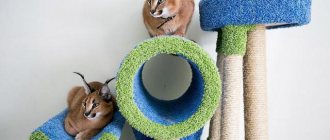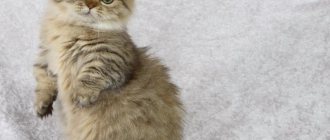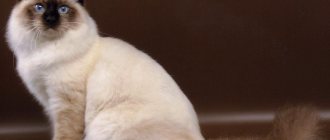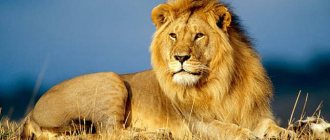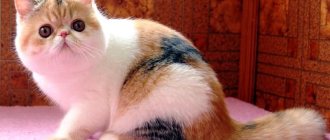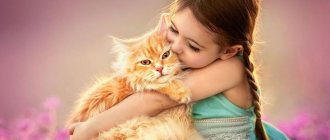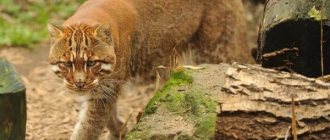Savannah
This animal amazes others with many of its characteristics, namely height, weight, etc. But the main surprise awaits those who decide to buy a kitten of this breed for themselves. The price is truly astronomical, although it is due to the fact that this breed has only 1 thousand individuals, and the first offspring were born only in the spring of 1986.
The basis of this breed was the domestic cat and the wild African serval. As a result, an animal was born, distinguished by its unique color, large ears, long legs, as well as fantastic jumping ability (up to 3 meters) and love for the water element. Savannah not only loves to swim, she is an excellent swimmer and is able to cover enormous distances across the surface of the water.
In addition, the Savannah has a developed intellect, she has an easy-going character and is devoted to her owner.
Liger
The tiger is considered to be the largest predator of the cat family, but there is an animal that defeats it. The liger is a hybrid of a lion and a tigress that is bred in captivity.
Liger Hercules
Interesting features of this unusual species:
- the liger Hercules was listed in the Guinness Book of Records as the largest cat on Earth;
- has a weight of 400 kg and a height of 3.7 meters;
- there are 25 individuals of this species in the world;
- ligresses are capable of childbearing, which is not typical for hybrids;
- ligers love to swim.
Maine Coon
This breed rightfully takes second place in the list of the largest cat breeds. Representatives of this breed have a weight of about 15 kilograms and a rather menacing appearance. At the same time, they find a “common language” with both adults and children, without offending pets either.
These animals have a characteristic color and a powerful tail, like raccoons. Thanks to these features, the name appeared, which translated means “Mensky raccoon”. Maine is the name of the state in the United States where the ancestors of Maine Coons were once kept on farms.
The breed is practically devoid of disadvantages, with the exception of its astronomical cost. Cats are easy to train and always demonstrate nobility, intelligence, calm disposition and grace.
10 ABNORMALLY BIG CATS IN THE WORLD
Irbis - snowy beauty
An unusually beautiful leopard with smoky gray fur with black spots. The snow leopard lives high in the mountains and occasionally descends to the foot, following the migration of ungulate herbivores. In appearance, this strong cat resembles a leopard, but is squat and smaller. The body of the snow leopard is stretched, slightly raised in the sacrum area. The height of the withers is no more than 60 cm, and the body length ranges from 103 to 130 cm. The main habitat of the snow leopard is South and Central Asia.
The snow leopard rarely attacks humans or livestock. This can only happen if the cubs are protected. Snow leopards live in pairs and hunt and raise their young together.
They feed, train and raise their young, and the female mercilessly plucks fur from her belly to insulate her den.
Currently, there are no more than 7 thousand snow leopards worldwide. Unfortunately, snow leopards practically do not reproduce in captivity, so the population of these magnificent animals continues to decline. It is almost impossible to meet this rare endangered species in the wild; the snow leopard carefully avoids people.
Chausie
It is considered not only one of the largest, but, at the same time, the rarest breed, the weight of which can reach at least 14 and a half kilograms.
The breed was born in 1990 and is a hybrid of an Abyssinian cat and a jungle cat. The jungle cat prefers to live in swamps, which is why it is also called the swamp lynx.
As a result of hard work, breeders managed to get a cat that has the power of a predator and the docile nature of a domestic cat. Chausie cats are quite strong cats, with an athletically complex body, a large (comparatively) head, large ears, and green or yellow eyes. Despite such external characteristics, the breed is devoted to its owner and feels great around children.
Ragamuffin
California is considered the birthplace of this breed, and it was born as a result of the efforts of Ann Baker, who decided to modify the Ragdoll. So she began to crossbreed the Ragdoll with other cat breeds, such as the Persian, the Yard Longhair, and the Himalayan.
As a result of these efforts, a breed was born that was called “cherub,” but at the last moment it was renamed and began to be called “ragamuffin,” which means “ragamuffin.”
Adults weigh at least 10 kilograms and acquire impressive sizes, although they mature only at 4 years of age. The breed does not have a beautiful, proportional physique, but it is distinguished by a variety of coat colors.
Kurilian Bobtail
The list of the largest cat breeds is replenished with another giant, since adult individuals can weigh at least 7 kilograms.
This breed of cats was once moved from the Kuril Islands to the mainland at the end of the last century.
The breed is distinguished by the original shape of its tail, which is quite short (only 8 cm maximum) and somewhat resembles a pom-pom. If a cat of this breed has a tail longer than 8 cm, then this is considered a fault of the individual, and if its length is only 12 cm, then the cat can be removed from the competition.
Kuril bobtails are not afraid of either moisture or frost, although they do not like to swim, but at the same time they are excellent at hunting fish.
The behavior of this breed of cat is somewhat reminiscent of the behavior of dogs, since they are very curious, are highly active and never refuse long walks and fun games, involving various toys, where they carry them in their owner’s teeth, like dogs.
Tiger – striped perfection
This is the largest wild cat in the world. In size, the tiger is second only to the bear. The weight of a tiger can reach 250 kg, height at the withers is up to 1.15 cm. The body length of an adult predator is more than 3 meters. The largest tiger was killed in the middle of the last century in India, its weight was 388 kg. Currently, only six subspecies remain, the habitat of which is concentrated in Asia.
A strong, muscular, elongated body, a more developed front part, a round head with a convex skull and a bright striped color - this is a brief portrait of a tiger. The most common color is red (of varying intensity) with black stripes, but there are also individuals with white and gold colors. Such unusual colors are associated with genetic disorders.
The tiger is a territorial animal and always hunts alone. The feeding territory of one animal is from 300 to 500 km. Tigers rarely quarrel with each other; if the amount of prey decreases, attacks on livestock and people begin. Possessing excellent night vision, the tiger prefers to hunt in the morning or evening. The tiger prefers to follow the tracks of its prey or wait for it in ambush, for example, near a pond. Unlike the lion, the tiger is very concerned about cleanliness; before going out to hunt, he always bathes or rolls out in the snow to fight off the smell that could scare off the prey.
A tiger can attack people if the boundaries of its territory are violated or if the food supply decreases. People are easy prey for this predator.
Now, due to a decrease in the population, such cases occur extremely rarely, and when a tiger encounters a person, he prefers to retreat. But before, attacks by man-eating tigers were recorded more than once. The Bengal tigress is widely known and has killed more than 400 people. It was suggested that a tiger, having tasted human flesh, would continue to prefer this type of prey.
All tiger subspecies are classified as endangered and are listed in the Red Book. Tiger hunting territories are protected by the state. A breed of cat was developed that resembles a miniature tiger, called the Toyger.
Norwegian Forest Cat
Due to the fact that the forest cat has long, fluffy fur, it seems that this animal is quite large. In fact, adults generally weigh no more than 9 kilograms.
There is a legend that this breed of cats was brought to Scandinavia by the Vikings in the holds of their ships. What these cats did on ships was to catch rodents, saving sailors from hunger and the bubonic plague, which was spread by rats.
In northern latitudes, cats became slightly domesticated, beginning to live next to humans. In 1934, the stage of breeding work with the Norwegian Forest Cat began, for which purebred representatives of this breed were sought throughout the world, as well as throughout the country. In 1976, the breed was officially recognized throughout the world.
The Norwegian cat is distinguished by its stable psyche; in addition, it is brave and strong, with the skills of a real hunter. These cats are not afraid to be with dogs that have the same easy-going nature, or near children. The Norwegian Forest Cat is considered to be one of the smartest.
Turkish van
Eyes are the pride of the breed
Looking at luxurious, fluffy cats, the question of their origin involuntarily arises. And their origin is curious - the Murki and Barsiki of Turkish streets, aboriginal animals. Only thanks to two Englishwomen who went to Turkey in 1955, the world learned about the new breed. Sonia and Laura paid attention to the beautiful animals; the girls managed to take a couple of kittens with them. They laid the foundation for a new breed, registered in 1969.
Turkish Vans are distinguished by their powerful physique and strength. The weight of an adult cat is 7-10 kg, cats are slightly smaller. A distinctive feature of the representatives of the breed is semi-long wool without undercoat.
Another feature is the color: completely white, a little red on the head (near the ears) and a completely copper tail.
Representatives of the breed love to play; this trait remains with them throughout their lives. Also, Turkish Vans are excellent swimmers, they love water and bathe often. When getting such a cat, you should give it bath days, giving it the opportunity to swim.
Among these cats there are many long-livers, having crossed the 17-year mark. Average life expectancy is 13 years.
In Russia, only one nursery is best known, breeding Turkish Vans.
Siberian cat
According to some experts, the Norwegian cat and the Siberian cat have common ancestors. Despite this, the Siberian cat is distinguished by both intelligence and intelligence. Moreover, its weight can reach 12 kilograms.
These cats grew and developed in the conditions of the Far Eastern taiga, so they are absolutely fearless animals that are not afraid of their natural enemies.
The Siberian cat is not only smart, but also beautiful, and also not spoiled by selective artificial selection. She is an excellent example of a real hunter, as she is able to hunt even hares.
The Siberian cat has a calm and balanced disposition, which helps her find a “common language” with both adults and children. At the same time, she will easily show who is “the boss”, regardless of who is in front of her, a cat or a dog.
Lion is the king of the animals
A dangerous predator who is not alien to nobility and greatness. The weight of a lion can reach 250 kg, and the height at the withers is about 123 cm. The length of the body ranges from 170 to 250 cm. In its structure, a lion is very similar to a tiger. Color varies from dark brown to sand. Lions are the only ones from the family of big wild cats to have a small tassel at the tip of their tail. Females differ from males not only in their smaller size, but also in the absence of a mane, the main decoration of a lion. It is not for nothing that he is called the gentleman of the world of predators. His proud, majestic demeanor and noble warning of the start of the hunt with a royal roar make one admire and admire this animal from afar.
They are the only ones from the family of big wild cats that do not live alone, but in peculiar families - prides. Typically, a pride includes females, cubs up to three years old and several males. The pride is led by a leader, an experienced and strong male. During the hunt, females usually serve as beaters, while males wait in ambush. It is almost impossible for an outside lion to get into the pride; an exception is made only in the case of a female vacancy. As a rule, the number of prides is the same and is regulated, obviously, depending on the food supply.
The lion's extant range is in Africa, with a small population in India.
British Shorthair
Thanks to its powerful body and short hair, it seems that this is a huge, strong cat, although in fact males weigh no more than 9 kilograms, and females - 6 kilograms.
The breed has an independent character and does not like pleasantries. She is able to endure prolonged loneliness, although she loves her owner very much and misses him if he is not at home. Because of its unobtrusiveness, it received a second name - “cat for a businessman.” He is wary of strangers and does not let them get closer than a couple of meters to him. If he wants, he can easily catch a rodent.
They accept affection only when they want it themselves, while demonstrating a sense of self-worth.
Ragdoll
This is a very beautiful breed of large cats, distinguished by a very original appearance. The very history of the origin of the breed is unusual: in the early 60s of the last century, after an accident, the Angora cat's activity and pain threshold sharply decreased.
Her breeder owner decided to cross the changed Angora with a Burmese colorpoint cat. The result was incredibly beautiful and very calm kittens. rag doll - suited the breed perfectly .
These big cats quickly earned worldwide popularity thanks to their owner-friendly nature.
The characteristics of these largest domestic cats are as follows:
- The weight of a male is up to 12 kg, a female is 6–8 kg.
- Body length - up to a meter.
- The body is massive and very well developed.
- Strong limbs with rounded paws.
- Between the fingers there are tufts of wool.
- The head is wedge-shaped, the muzzle is rounded.
- Thick cheeks, wide nose.
- Oval slanted eyes.
- Fluffy “collar” on the neck and around the muzzle.
- The ears are rounded.
- Fluffy tail of medium length.
Ragdolls come in a variety of colors:
- Bicolor: light body, legs, belly and chest are white, tail, ears, muzzle are dark.
- Color point - the color is similar to the Siamese: light body, dark paws, tail, ears and muzzle.
- Mitted - color point plus white socks, bib and lower jaw.
Cats of this large breed are very sociable, affectionate, and devoted to their owners . But due to its overly pliable nature, families with children should avoid keeping this breed: in an attempt to play, children can cause irreparable harm to the kitten.
British Shorthair
This short-haired aristocrat cat came to us from foggy England; it is one of the largest cat breeds. Distinctive features are as follows:
- massive body;
- round head;
- plump cheeks;
- pleasant to the touch, like plush wool;
- straight ears set wide apart;
- around the neck there is a fold of leather;
- eyes are round, bright orange;
- maximum weight is about 12 kg.
Domestic Britons are distinguished by their independent, proud character , behave with dignity and will not forgive rude treatment towards themselves. They recognize only one owner, and they may not survive separation from him. They are sociable and active if they treat themselves well, but become withdrawn loners if they are not given proper attention.
Pixie bob
This cat breed is considered a national treasure of the United States and its export is prohibited by law.
The breed was bred artificially. The breeders' task was to obtain a forest lynx that was not at all large in size. All that remains of the lynx are the tassels on the ears and unique colors, as well as a short tail. Adults weigh from 5 to 8 kilograms.
Despite the presence of lynx genes, these cats are distinguished by their calmness and love for their owner.
